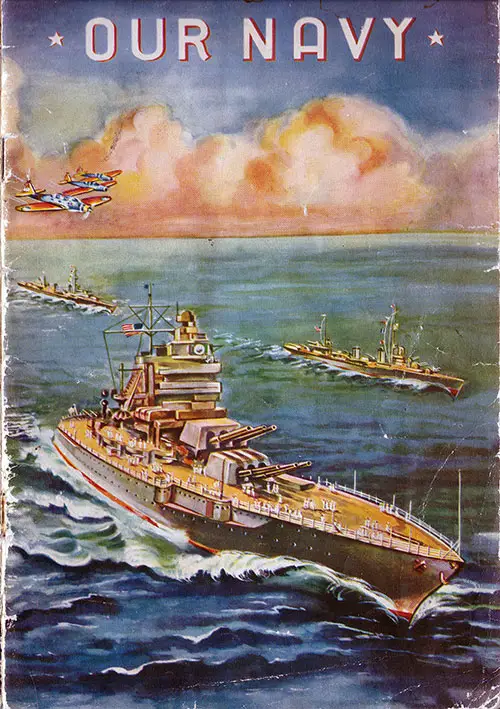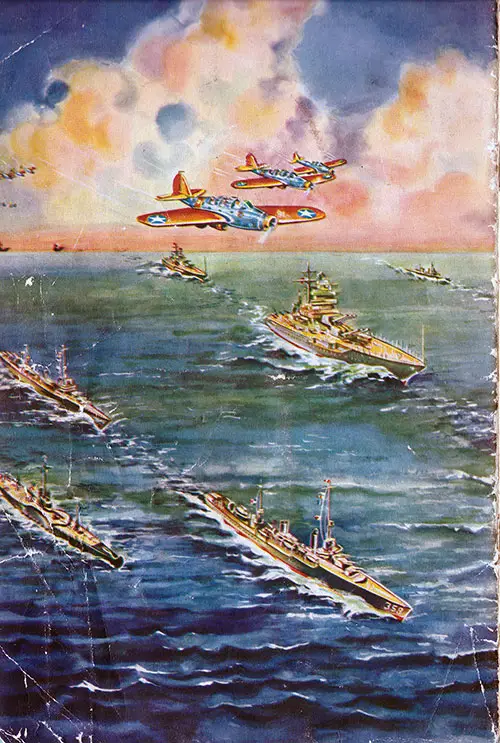Our Navy in World War II - 1945

Front Cover, Our Navy: The United States Navy in 1945 Brochure. | GGA Image ID # 1d64f4bd47
Illustrated discussion of the US Navy and our "two-ocean" Fleet, capable of protecting our coasts and combat-ready in either or both oceans. The Fleet is the heart of the Navy. All shore establishments, bases, auxiliary craft, and bureaus exist only to serve the Fleet.
Its Part of Our National Defense
The defense of our country has always been of major concern to all of us. Today, with most of the world embroiled in war, our defense needs are greater than ever before in the history of our nation.
Protected as we are by great oceans to the east and west, our defense must be based on the idea of keeping potential enemies from approaching the shores of our own country and, if possible, from gaining footholds in any of the countries of the entire Western Hemisphere.
With this basic idea in mind, our Navy becomes all important. More ships, more trained men, more planes, more outlying bases become our need.
To provide for this emergency. Congress in 1940, appropriated funds totaling over $5,000,000,000 for a naval building program. When completed in 1946, as planned, the United States fleet will be the most powerful force that ever sailed the seas.
We can be certain of having a "two-ocean" fleet, capable, so far as can be foreseen, of protecting our long coast lines against any combination of powers that might choose to attack us in either or both oceans.
This tremendous building program would not now be so urgently necessary were it not for the policy of disarmament and limitation which we have followed ever since this nation was founded over 160 years ago.
The first United States sea-going Navy of 1776-1777 was disbanded after the Revolutionary War when all the ships were either sold or given away.
With few exceptions, the naval vessels which saw service in the undeclared war with France (1798-1800). and in the war of 1812, were sold, and only gunboats for defensive purposes retained.
Success of the Union Naval Forces in the Civil War gave impetus to a belief that a strong navy could be improvised quickly in time of war and therefore it was unnecessary to maintain a "Standing Navy" in time of peace. After the Civil War, the Navy was cut down to half its wartime size.
The Civil War introduced many new ideas in naval construction —ideas which were used and expanded by all nations except the United States, which for 20 years did not build any new ships. In 1883, however, some construction was started.
The Navy played an important part in the Spanish-American War, but when the war was over, another ship building holiday took place.
Prior to our entrance in, and during the World War, our Navy was greatly expanded, but the most significant decline in our Navy after a war was arranged in 1921—and by this country.
Starting in 1922, as a result of the Washington Naval Treaty, we sank or scrapped 31 capital ships as a peace gesture. The United States threw away the best part of the greatest potential Navy in the world, hoping that by so doing peace could be maintained in the world.
From 1922 to 1927 our naval ship-building ways lay dormant, during which time other nations were expanding their navies. In 1930 the London Naval Treaty again removed many additional combatant vessels from our forces at sea During the period 1922 to 1933 only 24 replacement vessels were built or authorized.
In 1933, however, we began to build up our Navy. We had emerged from a period of trying to maintain world peace through disarmament. It required nearly four years to regain the organizations, skilled workmen, and building ways necessary to carry out actual construction on a large scale.
In spite of all difficulties, from 1933 to 1940, 137 combatant vessels were constructed and added to the fleet. These vessels included Aircraft Carriers, Cruisers, Destroyers and Submarines.
The Congress appropriated for twenty combatant vessels in 1935, twenty-two in 1936, and thirty in 1937. In 1938 the Navy was authorized to exceed treaty tonnage by 20 per cent.
Early in 1940 came the 11 per cent blanket increase. Almost immediately after Hitler had marched on France, the 70 per cent supplementary increase became law. The "two-ocean" fleet was to become a fact—a fleet which will, in 1946, be the most powerful striking force afloat.

Back Cover, Our Navy in World War II, 1945. | GGA Image ID # 1d654a8149
THE FLEET
The Fleet is the heart of the Navy. All shore establishments, all bases, all auxiliary craft, all bureaus, exist only to serve the fleet. With the exception of small forces on special duty, the United States Fleet contains all combatant vessels in active commission.
On February 1, 1941, the Fleet was subdivided into three active Fleets—the Pacific Fleet—the Atlantic Fleet—and the Asiatic Fleet.
By far the largest, and most important, is The Pacific Fleet which, since the European War began, is based in and around the Hawaiian Islands. Attached to this Fleet are 12 Battleships, six Aircraft Carriers, and numerous Cruisers, Destroyers, Submarines, Naval Planes, and Auxiliary Vessels of all kinds.
This Fleet is divided into three major Forces—Battle Force—Scouting Force—and Base Force. Each individual ship is designed for, and assigned to carry out, some specific function. No one type can embody all the offensive and defensive essentials; weight must be sacrificed for speed, bulk for maneuverability, etc.
The Battle Force
The Battle Force consists of the main combatant units of the Fleet—Battleships which are capable of destroying any vessel they may encounter—Fast Destroyers designed to deliver torpedo attacks against the enemy—Light Cruisers which support the Destroyers, and repel enemy Destroyer attack, and which also screen or protect the Battleships—Aircraft Carriers with their swarm of fighting planes which bomb and harass the enemy. It consists, too, of planes carried by Battleships and Cruisers, which are used mainly for spotting and scouting work.
The Scouting Force
The Scouting Force is charged with determining the location and possible intentions of the enemy. It includes Submarines which are admirably suited to their task as long distance scouts. Because of their ability to submerge and conceal themselves. they are able to make their way close to enemy ports or shipping lanes and report enemy ship movements.
Long range Patrol Planes, flying mainly from shore bases, scout large segments of the ocean and can spot any enemy forces and report their location and size, by radio.
The Scouting Force has Heavy Cruisers which develop the early contacts with the enemy made by Submarines or Patrol Planes. Cruisers are able to operate in heavy weather which may handicap movements of patrol planes or even submarines.
The armament of these Heavy Cruisers makes it possible for them to push through the advance lines of the enemy to determine his full strength and possible battle plan.
The Base Force
The Base Force consists of Auxiliary, Supply and Repair Vessels, as well as planes, which service the Fleet. These vessels are not designed for combat, but are absolutely essential to the successful operation of the Fleet. They are mobile, and can accompany the Fleet to whatever new far distant bases may be seized or established—where they can make available their facilities.
The Pacific Fleet is the only one of our three Fleets which is fully organized and complete. The Atlantic Fleet, today, is only a nucleus of what it will be when our "two-ocean" naval building program is completed, but it is organized along the same general lines as the Pacific Fleet and is readily expansible as new ships become available.
At present, however, the Atlantic Fleet consists of several Battleships—two divisions of Cruisers—several divisions of Destroyers—a number of Submarines—planes and miscellaneous auxiliary vessels and transport ships.
The Asiatic Fleet is only a covering or delaying force of several Light Cruisers, a few Destroyers and Submarines, and Naval Planes. This fleet is not intended to be a major sea power, but its purpose is to delay or harass an enemy which might threaten our island possessions or our continental coast.

The Fleet of the US Navy Containing All Combatant Vessels in Active Commission. Our Navy, 1945. | GGA Image ID # 1d653ccb9e
